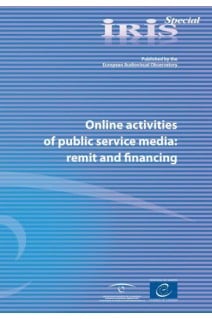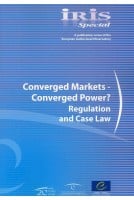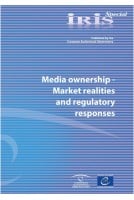- Online only



The difficulty in deciding which online services receive public funding due to a public service remit is one of the major issues currently being tackled by EU governments. The European Audiovisual Observatory has just published a major new report giving invaluable background reading on the subject of Online activities of public service media: remit and financing. This latest IRIS Special has been prepared by the Saarbrücken-based Institute of European Media Law and brings together contributions from various authors. This new publication tackles issues such as the definition of a public service media, current funding models for broadcasting or indeed the pertinence and practicability of a public value test for New Media services of public service media.
The keywords in the field of broadcasting today are digitisation and (technical) convergence. Digitisation has led to a big increase in the number of channels and in the amount of text and audiovisual content available, which has in turn been accompanied by further differentiation with regard to programming and means of distribution. The media companies and broadcasters operating in the market are increasingly being joined by private individuals who post publications or other offerings on the Internet, with the result that it is becoming harder and harder to differentiate between the various media. Both the online offering of a traditional newspaper and the website of a public service TV channel provide the individual with information in the form of text and images and with audiovisual film material. Text, pictures, sound and video are increasingly merging into “multimedia” and all content can be received on a wide variety of terminal devices, from PCs to mobile telephones.
In light of these changes in the media sector, it is crucial for ensuring the political awareness of the public in a democracy to keep bearing in mind what demands have to be met by media in general and public service broadcasters in particular.
A must-read analysis of the challenges currently facing PSM in their development of new on-line services
Content list
Introduction
1. The European framework regarding online activities of public service media
1.1. Council of Europe
1.2. European Union
1.3. Conclusion
2. The remit of public service media on the Internet
2.1. The media at the beginning of the global information age
2.2. Public service broadcasting on the World Wide Web
2.3. Freedom of speech and freedom of expression and the online remit
2.4. Conclusion
3. Broadcasting funding models in selected European states
3.1. Sources of funding for broadcasting services
3.2. The licence-fee funding model
3.3. Conclusion
4. Licence fee reform and online remit in Danish public service media
4.1. Introduction
4.2. The Danish licence fee funding system
4.3. The Danish regulatory structure of public service
4.4. Conclusions
5. Funding of public service media in Germany
5.1. Introduction
5.2. Reasons for the change in German funding
5.3. The new household orientated licence fee
5.4. State independent funding
5.5. Two years later – experiences with the new law
5.6. The “new licence fee” in terms of state aid law
5.7. Conclusion and outlook
6. Funding of the Hungarian Public Service Media
6.1. The organisation of Hungarian public service media
6.2. The funding of Hungarian public service media
6.3. “New media” services of Hungarian public service media
6.4. Concluding remarks
7. The Public Value Test and its implementation
7.1. Responsible institutions
7.2. The procedure foreseen by national legislation
7.3. Duration and cost
7.4. Conclusion
8. Public value test: fit for purpose?
8.1. PSM in the digital age
8.2. New PSM online services within the public service remit
8.3. Amending the public service remit to include new PSM online services
8.4. Public value test for significant new PSM online services
8.5. Conclusion
9. The ex ante test and its characteristics in national legislation
9.1. Introduction
9.2. The Adoption of the 2009 Communication
9.3. The impact of the new Communication: how has the ex ante test worked in practice?
9.4. Next Steps?
Conclusion





The difficulty in deciding which online services receive public funding due to a public service remit is one of the major issues currently being tackled by EU governments. The European Audiovisual Observatory has just published a major new report giving invaluable background reading on the subject of Online activities of public service media: remit and financing. This latest IRIS Special has been prepared by the Saarbrücken-based Institute of European Media Law and brings together contributions from various authors. This new publication tackles issues such as the definition of a public service media, current funding models for broadcasting or indeed the pertinence and practicability of a public value test for New Media services of public service media.
The keywords in the field of broadcasting today are digitisation and (technical) convergence. Digitisation has led to a big increase in the number of channels and in the amount of text and audiovisual content available, which has in turn been accompanied by further differentiation with regard to programming and means of distribution. The media companies and broadcasters operating in the market are increasingly being joined by private individuals who post publications or other offerings on the Internet, with the result that it is becoming harder and harder to differentiate between the various media. Both the online offering of a traditional newspaper and the website of a public service TV channel provide the individual with information in the form of text and images and with audiovisual film material. Text, pictures, sound and video are increasingly merging into “multimedia” and all content can be received on a wide variety of terminal devices, from PCs to mobile telephones.
In light of these changes in the media sector, it is crucial for ensuring the political awareness of the public in a democracy to keep bearing in mind what demands have to be met by media in general and public service broadcasters in particular.
A must-read analysis of the challenges currently facing PSM in their development of new on-line services
Please note that in accordance with our terms & conditions, PDF/epubs may only be purchased by private individuals.
